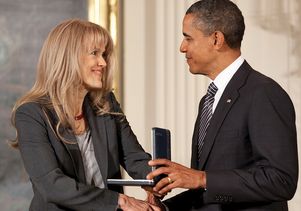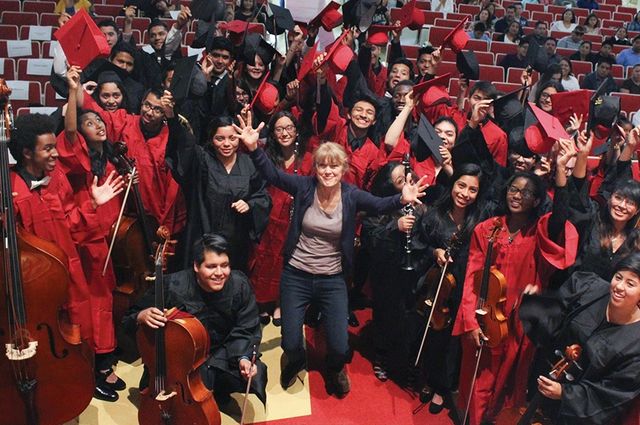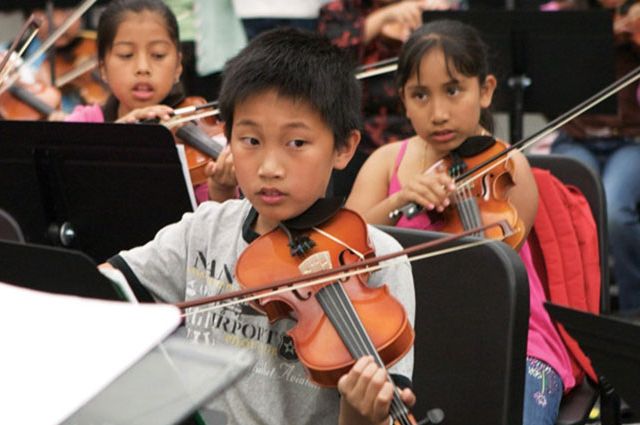Margaret Martin was walking through the Hollywood Farmers’ Market on a Sunday morning in 1997 when she witnessed a scene that would change her life — and, in turn, the lives of thousands of at-risk youth in Los Angeles and well beyond.
Martin watched from a distance as a group of teens who appeared to her to be members of a gang stopped in front of a small boy playing Brahms on a tiny violin. The child was Martin’s 5-year-old son.
Initially apprehensive, Martin quickly realized she was witnessing something remarkable. “They just stood there, as my son moved from one piece to another,” she recalls. “And after a few minutes, I watched them take out their own money and lay it gently in my son’s case. I was completing a doctorate in public health focused on what it takes to make a healthy community, and here were these young men teaching me that they would rather be doing what my son was doing than what they were doing, but they never had the chance.”
Martin was no stranger to the adversity that prevents many people from pursuing their dreams. A domestic violence survivor, she supported herself from the age of 15, gave birth to her first child when she was 17 and spent a year in her 20s homeless with her two children, sleeping on an office floor. At age 33, she enrolled at Los Angeles City College, and 10 years later she completed her doctorate at the UCLA Fielding School of Public Health.
In 2001, with a $9,000 initial contribution from the Rotary Club of Hollywood and a small group of founding board members, Martin launched Harmony Project, a program to promote the positive growth and development of at-risk youth through the study, practice and performance of music. With mentoring from the professional musicians employed by the program, students are engaged in music classes and ensemble rehearsals 5-12 hours a week year-round, tuition-free, until they graduate from high school.

The program started with 36 participants from disadvantaged homes in Los Angeles. Eight years later, Martin was at the White House representing Harmony Project to receive from then first lady Michelle Obama the Coming Up Taller Award — considered the nation’s highest honor for an arts-based youth program. Two years later, Martin returned to accept the Presidential Citizens Medal, the nation’s second-highest civilian honor.
Today, Harmony Project reaches 2,000 youth in low-income areas of Los Angeles designated as gang reduction zones, with affiliated programs in nine other regions across seven states. Approximately 3,000 other young musicians are now enrolled in cities that include San Francisco, Phoenix, East St. Louis, New Orleans, Miami and as far east as Hudson, New York.
In January 2016, 40 standout string students from Harmony Project Los Angeles performed on stage at the Super Bowl halftime show with pop stars Beyoncé, Bruno Mars and Chris Martin, along with Los Angeles Philharmonic conductor Gustavo Dudamel.
On May 8 in San Francisco, the two-time Fielding School graduate — Martin earned a master’s in public health in 1993 in addition to her doctorate — will deliver the George Armstrong Lecture at the annual meeting of the Academic Pediatric Association. It’s an honor and national award that Martin shares with Dr. Benjamin Spock, Marian Wright Edelman and UNICEF, among many others.
Martin credits her Fielding School education with informing her approach to starting Harmony Project. “As an academic, I wasn’t going to do anything that wasn’t research-based,” she says. In developing the blueprint for the organization, Martin drew from a RAND study on the elements of arts-based programming that promote pro-social behavior in youth:
- Allow participants extended participation. The average length of time that members of Harmony Project's 2016 graduating class spent in the program was seven years.
- Provide complementary services beyond arts programming. Harmony Project counsels students to enroll in academic courses that can help them become college-eligible, provides parenting education and referrals to social services, offers college scholarships to graduating seniors who qualify, and assists students in applying for additional scholarship awards.
- Provide youth mentorship opportunities. Beyond the mentorship provided by the musicians, advanced students are trained to mentor their less-experienced peers.
- Promote accountability through regularly scheduled performances or presentations. Students demonstrate their proficiency at frequent recitals, as well as at other public performances in front of family and peers.
Harmony Project now stands on its own as a successful arts-based program for at-risk youth. Since 2008, 90 percent or more of the high school seniors who participated in the project for at least three years went on to college; these young people come, Martin notes, from neighborhoods where high school dropout rates approach or exceed 50 percent. Harmony Project can boast of two Fulbright scholars among their graduates.
In search of a scientific explanation for the striking academic success of Harmony Project participants, Martin contacted Nina Kraus, director of Northwestern University’s Auditory Neuroscience Laboratory. Kraus agreed to partner with Harmony Project on a randomized controlled study of the program’s long-term neurologic impact. Publishing a series of journal articles beginning in 2014, Kraus and her colleagues have presented neurological evidence that two years in the program “remodeled” the children’s brains in ways that significantly improve their cognitive function.
“The research from the Kraus lab shows that our kids are changing their own brains,” Martin says. “Music training within Harmony Project enables our students to overcome the negative neurologic impact of poverty and adverse life events on their capacity to learn.”
Martin believes these success stories have powerful implications for public policy and public health. In addition to academic successes, she points to the positive social network maintained by the participants, as well as the confidence, accountability and self-reliance Harmony Project fosters.
“We are consistently achieving outcomes that everybody wants, and we believe it’s because we have tripped over a Rosetta stone,” Martin says. “Most of our students are heading toward professional degrees. For them, poverty is over.”

This story was first published in UCLA Fielding School of Public Health Magazine.





